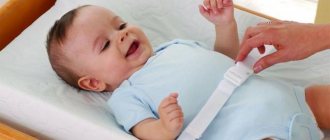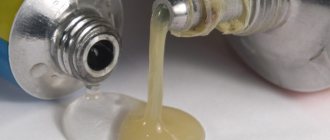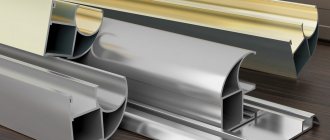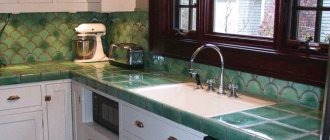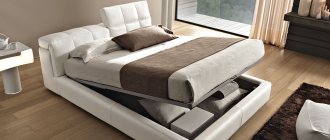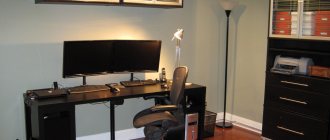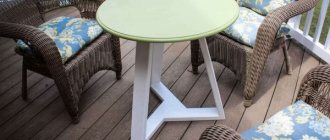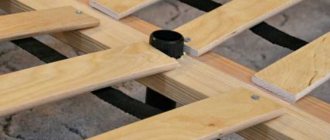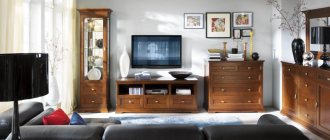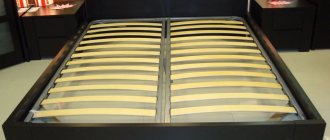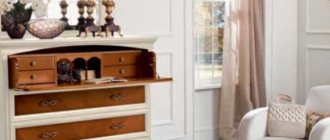A changing table is one of the main assistants for new parents... at least at first. After all, on average, a newborn baby needs to change a diaper every three to four hours. In addition, a changing pad is also necessary for daily massage, gymnastics, and changing clothes. It turns out that at first, in addition to the crib and your hands, the baby will be on it.
However, the question is: are baby changing tables really needed, or is this a whim imposed by marketers? After all, our mothers and grandmothers managed just fine without them. Indeed, you can swaddle and dress newborns, give them massages and other procedures on a bed, sofa or even a washing machine. But, you see, it is much more convenient and pleasant when there is a specially designed place for this. Moreover, there are so many types of tables that finding one that suits you in price, design, size and functionality will not be difficult. And when the child grows up, the table can (and should) be “re-qualified” as a chest of drawers for storing clothes, a toy cabinet, a bookshelf, a serving table or a desk (some models).
Which changing pad will be better for a child - folding or hanging, what to choose - a changing board or a mat, a changing chest or a shelf table? What to pay attention to and how not to make a mistake with your choice? Our material and a selection of photo examples of their application will help you understand these issues.
Benefits of using changing tables
You have to change clothes for an infant very often - at least five to seven times a day. Not every mother can do this while bending over the sofa - often after childbirth, temporary back problems arise when the load on the spine is undesirable. A specially equipped table in this case is a real salvation; its height (80-100 cm) allows you to avoid these overloads.
Floor-standing models of tables for changing a baby include not only a diaper, but also a number of drawers or shelves to accommodate all the things necessary for this process: nappies, diapers, baby vests and hygiene products.
Having these items at arm's length is not only convenient, but also advisable from the point of view of the baby's safety - he will not have to be left unattended while the necessary things are collected around the house.
Additional safety, unlike a regular table, is provided by the sides of the changing table, which run along its three sides and prevent the child from accidentally falling.
Convenience is the main criterion for almost any furniture, and the changing table fully corresponds to it. It is compact (you can choose a model that matches the size of the room) and multifunctional, very convenient for therapeutic or preventive exercises and massage.
You can use this design for quite a long time (up to a year), and then, if desired, convert it into a regular chest of drawers.
Should I buy an already used table?
Some may think that the best solution is to buy a used item. It would seem that what's wrong with this? Someone bought it, used it, and then it was no longer needed. Such a purchase is an unjustified risk. Superstitious people will never take things “from someone else’s shoulder” because of the energy of the former owner. Suddenly she's bad. The furniture could simply wear out and become unsalable. Whether to buy a used product or not is not a fundamental question. If you decide to purchase, check the product carefully.
There is another way to solve the problem of the lack of a changing table. Try making it yourself.
How to make a changing table for newborns with your own hands, watch in the video clip.
This master class will teach you how to make a mattress for newborns.
Types of changing tables
Modern designs of changing devices are not limited to the standard classic chest of drawers with three sides, but even this model comes in different types. For example, there may be a larger number of sides or a changing station expanded due to the folding surface.
Today, not only floor tables are available for sale, but also hanging and portable tables.
Suspension
The table is attached to a vertical surface and therefore does not take up much space. Like any other changing device, it is equipped with sides and a soft surface. There may be pockets at the bottom for storing diapers and other small items.
When installing a wall-mounted changing table, special attention should be paid to the reliability of the fastenings.
Folding
This is a type of hanging table, but with the ability to remove it by connecting it to a wall panel using a mechanism equipped with gas lifts (to avoid accidental collapse or, conversely, opening).
The shelves included in the design make it even more convenient and functional. This is a very compact option, suitable not only for a nursery, but even for a bathroom.
For this model, as well as for the hanging one, the surface itself to which the structure is attached is of great importance - it must be durable and withstand the weight of the child, therefore such a table is not recommended for installation on plasterboard partitions.
Portable
It is a board with sides and a soft surface, with fastenings for stability. This option is very convenient for small apartments: the diaper is securely fixed on the backs of the crib without taking up space in the room, and is also useful if you need to go on a trip.
In addition, this is the easiest and easiest type of changing device to make yourself.
Dresser
This is a classic model with drawers and a built-in or removable soft changing board with sides. Of all the above, this is the most capacious design, but also the most voluminous, so even compact models of chests of drawers are not suitable for small spaces.
Other types of structures
A bookcase is a structure with open shelves. Due to the absence of closed drawers, it is lighter than a chest of drawers and does not visually clutter up the space.
A folding changing table makes it possible to lay out the structure. This can be attributed to both the advantages of this model and the disadvantages: if it is not needed, it is removed and does not take up space, but at the same time, it is not very convenient to constantly disassemble and reassemble it.
A transformer is a model that combines several furniture options. For example, it can be transformed after the child grows up into a desk or be combined with a crib.
The last version of the model is the most difficult to manufacture independently. If you choose this design, it is best to give preference to finished products or order it from specialists.
How to choose for a newborn
When choosing a model, it is recommended to adhere to some rules:
- All materials must be environmentally friendly. It is important to protect your child from hazardous substances and components that can harm the baby’s health and lead to allergies.
- The changing cover must be moisture-resistant and water-repellent. Easy to clean from dirt.
- It is better to give preference to models with additional functionality in the form of shelves, hangers, drawers and other things. This will allow you to keep at hand all the necessary things for your baby’s hygiene.
- The top surface should be wide. After all, the child is growing quickly.
- The design must be stable. If there are wheels. They must have stoppers to stop movement.
- Must match your height. So that it is convenient for you to swaddle your baby and get the necessary things. For safety reasons, it is better to choose models that do not have sharp corners or irregularities.
- Pay attention to the quality of accessories and fittings.
Having decided to buy a changing table, you need to take care of the mattress, on the surface of which a waterproof bedding will be laid
What material is it made from?
When choosing a manufacturing material, the main criterion is safety, so it must be environmentally friendly and not contain any harmful or toxic impurities. The more natural the material, the better.
Natural wood is preferable, but not every budget can withstand such a load. Therefore, you can use substitutes, such as chipboard (chipboard) or MDF (medium density fiberboard) - they will cost much less, and in terms of safety and reliability they fully comply with the standards.
It is recommended to use the same criteria when choosing coatings - paint, varnish and soft board surface.
Under no circumstances should you use paint with a toxic composition or an unpleasant odor, and the material for the changing board, including the filler, should not cause an allergic reaction.
It is best to make a soft surface from holofiber (it is hypoallergenic) and natural fabric (for the top layer).
Nuances of choice
When choosing this design, important criteria are taken into account:
- material of manufacture;
- appearance;
- colors;
- price;
- hygiene, strength and durability.
If it is impossible to choose a model that ideally suits the needs of users, then you can assemble the changing chest yourself, and you can learn how to assemble it from the special instructions. Changing chests with or without a pattern, equipped with a table or additional elements, are considered comfortable interior items designed for caring for babies. They are represented by many types that have significant differences, and any parent should know how to correctly choose the optimal model that is safe, beautiful, durable and convenient for constant use.
What to consider before making a table
There is no need to rush and start assembling the chosen design as soon as such an idea appears. In order to avoid unpleasant accidents and subsequent rework, it is worth considering some points before proceeding directly to production.
Nuances:
- The table must be reliable and stable. Structural strength is one of the primary tasks facing the manufacturer. When choosing a suspended model, this concerns, first of all, the fastening mechanism.
- The dimensions of the table should facilitate a comfortable position for the baby when swaddling. If you make it yourself, you can choose the desired height of the structure and width, but it is better to make the depth standard or a little larger, but not less than 60 cm, since the baby can quickly “outgrow” the diaper.
- It is recommended to make the surface of the table soft, but at the same time, with a fairly rigid base. If you plan to sew the mattress yourself, then you need to lay an oilcloth between the outer fabric and the filling, or, even better, take a water-repellent fabric.
And, of course, we should not forget about the safety of all materials used, as well as reducing the risk of injury to the structure. To do this, sharp corners are polished, surfaces are smoothed, fasteners are recessed, and a minimum of fittings are used.
Precautions for use
In order not to harm the baby, you need to use the changing table correctly:
- It is strictly forbidden to use the structure if at least one of its parts has become unusable;
- do not leave the structure near an open fire or strong heat source;
- ensure the safety of the threads and the tightness of the bolts;
- It is forbidden to move the structure while swaddling the baby;
- after stopping the table, you need to fix the wheels, limiting their movement;
- Do not exceed the load. Most often it is 15 kg;
- The surface should be cleaned using a special spray. Do not use abrasive cleaners, bleaches or other chemical components. This can harm the baby's health.
Without a changing table it is difficult to imagine performing hygienic activities for a newborn. This is a very convenient design that makes life easier for young mothers. There are many models, differing in different functions and external design. This will allow you to choose an option for everyone.
How to make a dresser table with your own hands
Making a chest of drawers yourself is not a quick process and is quite labor-intensive: to do it well, you need to have some carpentry skills.
The easiest way is to attach a changing board with sides to a regular ready-made chest of drawers and equip it with a mattress. But if you want to build a structure from scratch, you will need an additional set of tools and materials.
Required tools and materials
In addition to the selected lumber (wood, chipboard or MDF), you will need appropriate carpentry tools and additional materials, the availability and quantity of which directly depends on the appearance of the planned structure.
You will definitely need:
- jigsaw or saw for cutting out workpieces;
- sandpaper;
- Sander;
- screwdriver, screwdriver;
- self-tapping screws or self-tapping screws;
- wood primer;
- tape measure, construction rectangle, pencil;
- furniture corners;
- confirmations;
- guides for drawers (two pieces for each);
- accessories.
Preparation of blanks
First you need to make a drawing of the future chest of drawers or select and print from the Internet the model that best suits your personal preferences. The model presented below is a classic one - a chest of drawers with drawers and an extended shelf for changing.
Next, the material is cut to the dimensions specified in the drawing (they can be adjusted if necessary) and the corners are rounded. For this process, it is best to use an electric jigsaw rather than a saw, as it will not cut rounded lines neatly.
After cutting you should get the following parts:
- sides 798 x 460 cm - 2 pcs;
- back side 732 x 848 cm - 1 piece;
- bottom of boxes 790 x 448 - 4 pcs;
- chest of drawers 818 x 460 - 1 piece;
- top shelf 850 x 480 - 1 piece;
- additional shelf 850 x 283 - 1 piece;
- facades 177 x 846 - 4 pcs;
- side panels of drawers 120 x 418 - 8 pcs;
- back panels of drawers 120 x 818 - 4 pcs;
- main sides 80 x 414 - 2 pcs;
- folding sides 79 x 394 - 2 pcs;
- rear side 243 x 850 - 1 pc.
If there is an opportunity and desire, then the back panel and drawers can be made of hardboard.
Now you need to thoroughly sand the workpieces. To do this, you will need a coarse sandpaper or sanding wheel first, and a finer one for finishing.
Creating grooves
Grooves for inserting one piece into another need to be made in the side parts and in the back panel of the chest of drawers - the future tabletop will become there. To form them you will need a jigsaw or a wood saw and a chisel.
The dimensions of the groove are as follows: the width of the entrance is 1-2 mm greater than the thickness of the board, and the depth is about 7-8 mm. The resulting grooves must be sanded or sanded.
Places for fastenings
The workpieces need to be marked with places where the fasteners will be located.
The following structural elements must be marked:
- furniture corners - 2 pieces - they will attach the top shelf to the sides;
- intersectional couplers - 2 pcs - fastening of an additional shelf;
- guides for drawers - 8 pcs;
- confirmations - other places of fixation.
All markings must be done as accurately as possible. The marked attachment points on the sides and sides of the future product should “mirror” each other, otherwise distortions will be inevitable in the finished chest of drawers.
After completing the markings and carefully re-checking all measurements, you can proceed to drilling the holes. In the sides of the base and the additional shelf for intersectional ties (rotary axis), they are made through, just as in the side planes for confirmations.
At the ends of the shelves, the holes are deepened by 4-6 cm, their diameter and depth must correspond to the size of the fasteners. For the guides, there is no need to additionally drill out the markings - using self-tapping screws, they are immediately attached along the intended line.
Assembling a chest of drawers
If all the previous steps were completed independently, then assembling the structure will seem relatively easy.
Sequencing:
- Install guides on the inner surface of the sides.
- Collect boxes.
- Install the bottom shelf (bottom of the chest of drawers).
- Secure the sides on the top shelf with confirmations.
- Connect the sides to the top shelf.
- Attach the back panel to the frame.
- Assemble the additional shelf and secure it to the base with a tie.
- Install fittings.
If necessary, you can attach legs (metal or plastic) to the structure for free air circulation under the chest of drawers or wheels for mobility. Finishing with paint or varnish is optional. If the chest of drawers was assembled from wood, before applying paint it is necessary to sand the product and walk over the surface with a primer.
Standard sizes
On the changing surface, the baby can be positioned with its legs or side facing the mother. Models with a longitudinal table are narrower and more compact, but dressing the baby in this position is difficult. If you choose a chest of drawers with this arrangement, in addition to access to the front with drawers, you will have to provide free access to it from the side, which is not always convenient.
Manufacturers claim that standard changing chests are suitable for children under one year of age. The size of the space for performing hygiene procedures can be from 70 to 100 cm. A length of 70 cm is suitable for a six-month-old baby, but for an older child more space is needed. If possible, you should immediately choose a model with a surface length of 90–100 cm. The width of the board should not be less than 44 cm, the standard height of the fence sides is from 15.5 cm. The number of drawers ranges from 1 to 5.
Wide chests of drawers with a changing table, on which the baby is placed with his feet facing his mother, are much more convenient to use, but they take up more space. True, here you don’t have to worry about a free approach from the side. A compromise between these models is a narrow chest of drawers with a folding or overhead table, which protrudes slightly beyond the dimensions of the furniture. In this case, the dressing area allows you to place the baby with his legs facing his mother.
Shapes and sizes of chests of drawers for cosmetics, furniture design options
Folding surface parameters: 66–77 cm wide and 70–96 cm long. The changing area in transformable furniture is 61–66 cm. The standard height of children's chests of drawers is about one meter (95–105 cm). The height of the furniture should be selected based on the height of the mother: it should be comfortable for the woman to lay the baby down and care for him without straining her back.
In the most stable chest of drawers, the height from the floor and the depth are approximately the same.
Manufacturing of other types of tables
If the room does not allow you to install a changing chest, you can consider the process of manufacturing more compact models.
Folding wall
It saves a lot of space in the room, but you need to make sure that the partition on which the structure will be attached is strong - preferably it should be brick or concrete.
In addition to standard materials and fasteners, this model will require gas lifts, which are installed on the product to prevent spontaneous “collapse”.
For convenience, you can make several shelves in the stationary part of the table. In addition to the necessary function of storing things, they will also serve as an additional retainer, since they increase the strength of the structure.
Assembly instructions:
- Cut the blanks according to the drawing, make rounded corners, and process them with a grinding machine.
- Make markings for fastenings and drill the necessary holes.
- Assemble the frame with shelves using furniture corners or confirmations (any reliable fasteners).
- Connect the frame to the back panel.
- Fix the sides on the diaper.
- Using furniture hinges, connect the frame and the lid.
- Install gas lifts.
All that remains is to fix the structure on the surface with a reliable fastening. It is advisable that it be designed for a weight of at least 20 kg.
Portable
Even someone who knows nothing about carpentry can handle making such a changing device. The design is a board with restrictive sides (two or three) and a mattress. The size of the board is approximately 60 x 95 cm, and the height of the slats is 6-10 cm.
Description of the assembly process:
- Cut out the blanks: base, side slats and headboard bar (you can do without it).
- Sand the surface and sharp corners.
- Connect the sides to the base using screws or self-tapping screws.
If you have the desire and opportunity, you can install a fastening mechanism on the base from below or cut out grooves (for secure fastening, for example, on the crossbars of a crib).
Often this design is covered with fabric instead of painting - this is quite convenient, especially if you sew a removable cover. In addition, due to the fabric, the table will slide less on a flat surface.
The mattress can be either removable or fixed on the surface of the diaper.
Why is the structure needed?
Changing chests for newborns are special interior items specifically designed for optimal care of infants. Their main purpose is to create comfortable conditions for performing actions:
- swaddling the baby;
- changing a diaper, and due to many additional elements it is possible to use numerous compartments to simplify this process;
- undressing the baby before bathing or changing clothes to go outside;
- carrying out a massage in comfortable conditions, and in this case narrow changing chests are not suitable, since significant free space is required to perform the actions;
- performing gymnastics for the child, if required in accordance with the health characteristics of the baby.
When choosing a chest of drawers with a changing table, it is taken into account that its base must be solid, and a folding or stationary frame must be used for support.
Often special changing chests with an add-on are chosen, and it is used to store many items necessary in the process of performing various actions with the baby. Many models are sold with a removable mattress made from moisture-resistant fabric, which ensures comfort for the baby. If this element is not included in the set, then it is purchased separately, after which it is placed on top of the table.
Decoration
The main ways to decorate changing tables are to cover them with paint and varnish. The color of the coating is chosen either to match the furniture or is used as an accent color.
The same principle applies here as in the case of any other furniture: a dark color hides the dimensions, but makes the room heavier, and light shades do the opposite.
Decorating with appliqués (you can choose the motif and technique at your discretion), as well as with fabric, is very popular. Most often it is matched to the tone of wallpaper or furniture upholstery.
Design and color
The children's room is traditionally decorated in light colors. Pastel shades, cheerful bright colors, combined models with multi-colored facades, drawings, photo printing, and appliqués look very elegant. The most common colors:
- white and all its shades;
- beige color scheme;
- pink, blue tones;
- light gray (alone or in combination with white);
- shades of natural wood, from dark brown to light sand.
Recently, luxury models made from exotic African wenge wood have become popular. It is quite natural that such furniture is very expensive, so designers have learned to imitate this shade on cheaper types of wood. The color palette includes all shades of burgundy, chocolate, and dark brown. The wenge chest of drawers is beautiful and practical, since stains and dust are not very noticeable on its surface. It is suitable for strict interior design styles such as minimalism, modern urban, loft.
Wooden chests of drawers in natural colors are chosen for children's rooms, the interior of which is designed in light colors.
How to sew a mattress for a changing station
Such a mattress will be useful not only for those who have a special device for changing. It can also be placed on a simple table.
Sewing a mattress is not difficult, but you must take into account the following points:
- you need to choose fabric with the most natural composition;
- the filler must be made from materials that do not cause allergies;
- The cut must be made from solid fabric so that there are no seams in places of contact with the baby’s skin.
It is better to choose moisture-repellent fabric for the mattress. You can sew an additional cover with a zipper (for easy washing) and line it with oilcloth inside. Foam rubber or holofiber is perfect as a filler.
Required tools and materials
You will need:
- main fabric and for lining (1.5-2 m each);
- filler (1.5 m);
- centimeter, scissors;
- chalk;
- threads, pins, needles;
- sewing machine.
You will also need an iron to steam the fabric and iron the seams.
Instructions for sewing a mattress
Once the fabric has been selected and the dimensions of the mattress have been calculated, you can proceed directly to cutting and sewing the product.
Procedure:
- Cut out blanks for the mattress and sides from the main fabric, lining and filling, not forgetting about the allowance for seams along the edges of the sides.
- Place the filler between the two lining parts and stitch the resulting “sandwich” several times.
- Sew the parts from the main fabric on three sides to make a “pillowcase”, turn the workpiece inside out and insert a “sandwich” into it.
- Fold the raw edge inward and sew. Sew around the perimeter.
- Bend the part of the side along (lengthwise) in half on the wrong side, sew the side seams and part of the longitudinal one, leaving an unsewn gap in the middle about 15-20 cm wide. Finish the seams and turn them inside out.
- Fill the side with filler and sew up the hole.
- Sew the edge to the base of the mattress by hand so that the seam runs from the bottom and does not come into contact with the baby’s skin.
The mattress can be decorated with ribbons, appliqués or soft toys. The choice of design is at your own discretion. The main thing is that the decor is not traumatic.
What can be replaced?
If you do not purchase a changing table, then parents begin to adapt to different conditions for changing the child, kneeling next to the bed, showing their imagination. In some cases, the diaper changer is simply a desk covered with oilcloth.
There are many disadvantages to any proposed replacement:
- if a sofa is chosen as a changing surface, it is not suitable for the child to develop coordination of movement and is quite dangerous due to the lack of installed limiters. Therefore, the main requirements when creating the stability of an improvised changing surface is the installation of sides;
- minimal functionality.
When purchasing furniture for a children's room, a rational approach is necessary. A changing table is one of the main tools you need to buy. This piece of furniture simplifies caring for the baby and can be a place to store children's clothes. Additionally, you can also read reviews on the forums.
Recommendations for making a changing table
In the process of making your own table, you need to remember some important points.
Recommendations for work:
- it is necessary to correctly calculate the design parameters and make a competent drawing;
- if a ready-made diagram is taken as a basis, then you need to strictly adhere to the specified dimensions when cutting out parts;
- if you are not confident in your capabilities, then it is better to entrust the cutting to professionals;
- the design should not be traumatic, therefore all sharp corners require rounding and grinding;
- Sanding work should not be done at home, since flying dust and small wood particles can damage furniture upholstery - a non-residential premises is better suited for this purpose;
- The use of toxic paint and varnish should be avoided;
- fastening with screws and a tie will enable the structure to be “collapsible”;
- Do not forget about the reliability and strength of fastening mechanisms when manufacturing and installing a wall-mounted pelenator;
- It is better to cover all external heads of self-tapping screws or screws with special plastic covers;
- It is recommended to make a changing mattress moderately hard with a soft surface;
- for sewing a mattress, it is preferable to choose natural fabrics, hypoallergenic and moisture-resistant;
- The cover, sewn to be placed on the mattress, will facilitate the process of washing and steaming.
Today, stores offer a huge selection of different models of swaddling pens. However, a table made by yourself will not only cost much less than a purchased one, but will also become an exclusive creation with a piece of the soul invested in it.
Posting rules
The changing type of chest of drawers can be located in different parts of the bedroom, but often it is installed along the wall of the room. Its width then practically does not matter, since it still will not interfere with walking around the room.
If you purchase a 2 in 1 design, then take into account that using any element in it should be convenient, so you often have to move the chest of drawers a little away from the wall. If the room is too small, then a corner piece of furniture is selected. A photo of such a product can be viewed below. It will be roomy and comfortable for constant use.
Before removing furniture from the shipping box, you should ensure that it is intact. If you purchase a changing chest on wheels, its location may change periodically. This is relevant if it is used not only for swaddling, but also for washing the baby, since it can be moved to the bathroom at any time. It is recommended to choose models with rubber wheels. It is desirable that they be replaceable, since if an element is damaged, it can be quickly and easily replaced.
